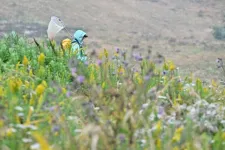(Press-News.org) Summer 2024 is on track to be the hottest on record for hundreds of cities across the U.S. and globe. Even in Antarctica, during the peak of its winter, extreme heat pushed temperatures in parts of the continent more than 50°F above the July normal.
In a study published on July 31 in the journal Earth’s Future, scientists, including researchers at the University of Colorado Boulder, revealed how heat waves, especially those occurring in Antarctica’s cold seasons, may impact the animals living there. The research illustrates how extreme weather events intensified by climate change could have profound implications for the continent’s fragile ecosystems.
In March 2022, the most intense heat wave ever recorded on Earth hit Antarctica, just as organisms in the southern region braced themselves for the long, harsh winter ahead. The extreme weather raised temperatures in parts of Antarctica to more than 70°F above average, melting glaciers and snow even in the McMurdo Dry Valleys, one of the planet’s coldest and driest regions.
As part of a Long-Term Ecological Research (LTER) project in Antarctica, the research team found that the unexpected melt followed by a rapid refreeze likely disrupted the life cycles of many organisms and killed a large swath of some invertebrates in the McMurdo Dry Valleys.
“It's important that we pay attention to these signals, even if they're coming from microscopic organisms in soils in a polar desert,” said Michael Gooseff, the paper’s senior author and professor in the Department of Civil, Environment and Architectural Engineering at CU Boulder. “They're the early responders to changes that could cascade up to larger organisms, the landscape and even us, far away from Antarctica.”
When Gooseff arrived in Antarctica in November 2021, the continent looked much like it had for the past two decades. As a fellow of the Institute of Arctic and Alpine Research (INSTAAR), Gooseff has led the LTER at the McMurdo Dry Valleys, a National Science Foundation-funded project, for the past decade. Nearly every Antarctic summer, he travels to the southern region to study its ecosystem and how organisms survive in extreme environmental conditions.
While most animals can’t tolerate the region’s dryness and cold, some microbes and invertebrates, including roundworms and water bears, thrive in this frozen desert. Water bears, or tardigrades, are tiny, eight-legged animals measuring 0.002 to 0.05 inches long. They can survive extreme conditions— as cold as -328°F and as hot as 300 °F —that would kill most other forms of life.
In 2022, all members of the polar expedition team left the continent in February, before the Antarctic summer ended. A month later, Antarctica experienced the most extreme heat wave on record, driven by an intense storm known as an atmospheric river, which transported moist air over long distances to the polar region.
The team’s sensors in the McMurdo Dry Valleys recorded air temperatures, which typically hover around -4°F in March, rising above freezing and exceeding the average by 45°F.
Satellite imagery and stream discharge measurements showed that the sudden warming wetted the valleys’ soil more than two months after the peak summer thaw, at a time when the land is typically dry.
In two days, after the heat wave passed, temperatures plummeted and the soil froze. This event happened during a critical transition period, when organisms hunker down and get ready for the dark, cold winter. Gooseff and his colleagues were curious about how animals in the valleys responded.
“These animals invest a significant amount of energy in preparing and shutting down for the winter,” said Gooseff. “When things start to warm up the following summer, they use energy to become active again. One of our major concerns with unusual weather events like this heat wave is that these animals might start using a lot more energy, thinking it's summer, only to have to shut down again two days later. How many times can they go through that cycle before they exhaust their energy reserves?”
He and the team returned to Antarctica the following summer, in December 2022. They sampled the soil and compared organisms living in areas that became wet to those that stayed dry during the heat wave.
They observed a 50% decrease in the population of Scottnema, a common roundworm, in areas that got wet. Scottnema is adapted to extremely cold and dry climates.
“The heat wave made the environment appear warm enough for things to get wet, creating a false start to summer. Some of the biology responding to these temperatures might be seriously disrupted by this,” Gooseff said.
Rapid swings between extremes in weather can disproportionately impact sensitive species like Scottnema, but they may have far less impact on other animals, such as tardigrades. These creatures have a higher tolerance for moisture, allowing them to proliferate as the environment becomes wetter.
“Changes in which species are in the soil and how big the populations are can have a major impact on the ecosystem’s food web and nutrient cycling," Gooseff said.
Previous research has shown Scottnema is responsible for about 10% of the carbon processed in the Dry Valleys’ soil ecosystem.
As climate change exacerbates extreme weather events in Antarctica, larger species are also being impacted. For example, in the summer of 2013, an unusual rainfall event along the Adélie Coast of East Antarctica killed all Adélie penguin chicks in the region. In July, temperatures in parts of East Antarctica climbed up to 50 °F above the usual winter average.
Gooseff and his team plan to continue documenting extreme weather events and their impacts on the Antarctic ecosystem.
What happens in Antarctica doesn’t stay in Antarctica, Gooseff said.
“The loss of ice shelves has pretty dramatic impacts on the mass balance of our oceans, and it affects us even thousands of miles away.”
END
How Earth’s most intense heat wave ever impacted life in Antarctica
2024-09-04
ELSE PRESS RELEASES FROM THIS DATE:
Most states have higher child, adolescent firearm mortality rates, U-M study finds
2024-09-04
Injury-related mortality rates, including firearm-related deaths, among children and adolescents increased in almost every state between 2018-2022, according to findings from the University of Michigan.
Researchers from the U-M Institute for Firearm Injury Prevention analyzed mortality data from the U.S. Centers for Disease Control and Prevention's Wide-ranging Outline Data for Epidemiologic Research and found that nearly 90% of states saw an increase in mortality rates among children and adolescents overall during the study period.
North Dakota's numbers show the largest increase among states at 65% and Rhode Island saw the largest decrease ...
NASA’s Webb reveals distorted galaxy forming cosmic question mark
2024-09-04
It’s 7 billion years ago, and the universe’s heyday of star formation is beginning to slow. What might our Milky Way galaxy have looked like at that time? Astronomers using NASA’s James Webb Space Telescope have found clues in the form of a cosmic question mark, the result of a rare alignment across light-years of space.
“We know of only three or four occurrences of similar gravitational lens configurations in the observable universe, which makes this find exciting, as it demonstrates the power of Webb and suggests maybe now we will find ...
Three common variants increase the risk of Wolff-Parkinson-White syndrome
2024-09-04
Three common variants increase the risk of Wolff-Parkinson-White syndrome
Study by scientists at deCODE genetics/Amgen and collaborators in Denmark and the USA, on the genetics of accessory conduction pathways in the heart (Wolff-Parkinson-White syndrome), reveals that accessory pathways can cause rhythm disturbances, characterized by an overly fast heartbeat, which can be life-threatening.
Accessory pathways are found among around 0.3% of individuals, but their prevalence is likely higher as a majority of them do not cause symptoms that lead to diagnosis. It is believed that other individual factors can influence the likelihood of developing rhythm ...
AERA selects Elise Boddie to deliver 2024 Brown Lecture in Education Research
2024-09-04
Washington, D.C., September 4, 2024—Elise Boddie, James V. Campbell Professor of Law at the University of Michigan Law School, has been selected by AERA to present the 2024 Brown Lecture in Education Research. Her lecture, titled “Brown v. Board of Education and the Democratic Ideals,” will take place on Thursday, October 24, 6:30 p.m. ET, at Howard University in Washington, D.C., and will be livestreamed. Registration for in-person attendance and for the livestream will open in early September. The event is free and ...
Brown to lead $2.8 million NSF grant to create an undergrad research administration curriculum
2024-09-04
BIRMINGHAM, Ala. – Chris Brown, Ph.D., is a former researcher who now heads research administration at a university with more than $780 million in research expenditures. Yet Brown — like other research administrators across the nation — had to learn his profession on the job because there is no complete, formal, recognized career training for the thousands of people who have a version of “research administrator” in their titles.
To fill this critical gap, Brown, vice president for Research at the University of Alabama at Birmingham, will lead a three-year, ...
Traditional infrastructure design often makes extreme flooding events worse
2024-09-04
Images
Much of the nation's stormwater infrastructure, designed decades to a century ago to prevent floods, can exacerbate flooding during the severe weather events that are increasing around the globe, new research led by the University of Michigan demonstrates.
The problem lies in traditional planning's failure to recognize flood connectivity: how surface runoff from driveways, lawns and streets—and the flows in river channels and pipes—are all interlinked. The result ...
A new role for intelligent tutors powered by AI in brain surgery?
2024-09-04
Neurosurgery is perhaps one of the most demanding professions in healthcare. Surgeons spend long hours performing operations where expert performance means the difference between a good and bad patient outcome. While operative injuries are rare, when they occur, they can have serious, and lifelong consequences.
Researchers at the Neurosurgical Simulation and Artificial Intelligence Learning Centre at The Neuro (Montreal Neurological Institute-Hospital) of McGill University are striving to improve brain surgery training by designing real-time, intelligent tutors powered by AI. These systems are designed ...
MD Anderson research highlights for September 4, 2024
2024-09-04
HOUSTON ― The University of Texas MD Anderson Cancer Center’s Research Highlights showcases the latest breakthroughs in cancer care, research and prevention. These advances are made possible through seamless collaboration between MD Anderson’s world-leading clinicians and scientists, bringing discoveries from the lab to the clinic and back.
Protein expression atlas covers almost all cancer hallmarks
The Cancer Genome Atlas (TCGA) and Cancer Cell Line Encyclopedia (CCLE) provide DNA and RNA data from approximately 11,000 patient samples across 33 cancer types and 1,000 cancer cell lines, but limited protein information is available. Researchers led by Han Liang, Ph.D., Rehan Akbani, ...
At-risk butterflies more likely to survive with human help
2024-09-04
VANCOUVER, Wash. – Some of the butterflies most in danger of fluttering out of existence fare better when their habitats are actively managed by humans, a recent study found.
A team led by Washington State University researchers Cheryl Schultz and Collin Edwards analyzed data on 114 populations of 31 butterfly species in 10 U.S. states. Scientists have long warned that insect populations worldwide are falling rapidly due to the combined effects of climate change, habitat loss and pesticides. Overall, the research team found that these at-risk butterflies ...
National Cleveland Clinic survey examines generational divide in men's health
2024-09-04
Embargoed until 12:01 a.m. Wednesday, September 4, 2024, CLEVELAND: A new national survey by Cleveland Clinic revealed similarities and differences across generations when it comes to men’s health. The survey highlights health priorities and concerns among men; however, there were generational differences in health habits, mental health and the use of social media as a source of health information.
While 95% of men surveyed said living a healthy lifestyle is their top priority, findings show that different health behaviors exist among ...





